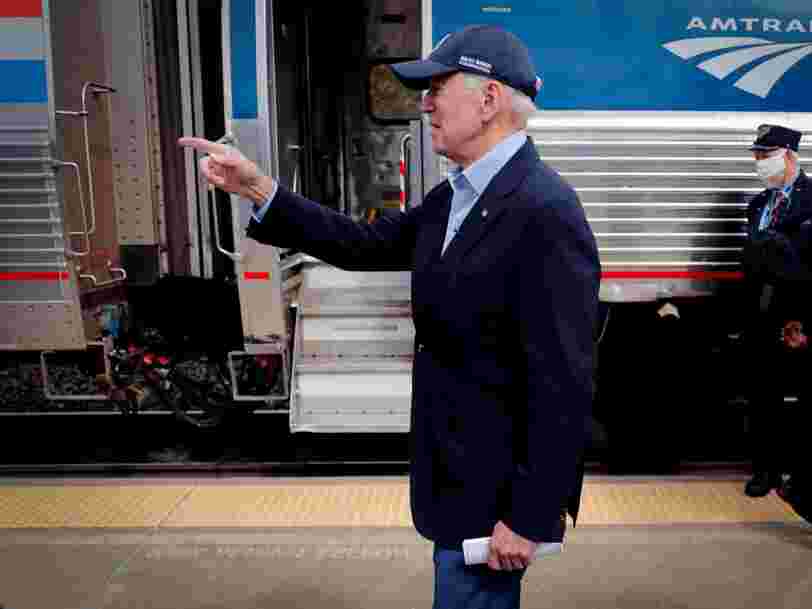What's in the infrastructure bill? Electric vehicles, clean energy, and public transit are all up for debate in Congress this week.
Juliana Kaplan,Grace Panetta | Publié le
- The Senate is taking up a $1 trillion bipartisan infrastructure bill this week.
- The plan includes $550 billion in new spending, $30 billion less than a prior proposal.
- It encompasses investments in public transit, clean energy, electric vehicles, and roads and bridges.
- See more stories on Insider's business page .
The US Senate is finally taking up the long-awaited $1 trillion bipartisan infrastructure package negotiated over the course of several weeks by a bipartisan group of senators and the White House.
The final version of the bill, which clocks in at 2,702 pages , includes $550 billion in new spending - $30 billion less than the original bipartisan agreement hashed out last month.
After clearing a key procedural vote on Friday, the Senate will begin the process of voting on amendments to the bill on Monday afternoon. The process of debating and passing the bill could stretch into the next week, possibly delaying the start of the Senate's August recess.
There will likely be more proposals on infrastructure spending from Democrats in the upcoming budget reconciliation package. Although Sens. Kyrsten Sinema and Joe Manchin have already expressed trepidation about Democrats' $3.5 trillion in proposed party-line spending, the bipartisan bill would still encompass a major investment.
Here's how it breaks down:
Roads, bridges, and transit safety
The deal will put $110 billion toward roads, bridges, and other projects. Those investments will "focus on climate change mitigation, resilience, equity, and safety for all users, including cyclists and pedestrians," according to a White House fact sheet . That includes:
- $40 billion for bridges, which would go toward repairs and replacements
- $17.5 billion for other "complex," major projects that aren't traditionally eligible for funding
- In addition, the deal would put $11 billion toward "transportation safety programs," with an emphasis on pedestrians and cyclists
Trains, buses, and ferries (oh my!)
The deal invests in both transit infrastructure and Amtrak, President Joe Biden's beloved form of transit .
- $39 billion for public transit, which would go toward upgrading and modernizing infrastructure, and increasing accessibility
- $66 billion for rail, which includes:
- $22 billion in Amtrak grants
- $24 billion in grants to help modernize the Northeast Corridor (a politically important route, which even has its own slew of Northeast presidential primaries named after it: the Acela primaries ).
- $12 billion toward intercity rail
- $5 billion in "rail improvement and safety grants"
- $3 billion for other safety improvements
- $2.5 billion for zero-emission buses
- $2.5 billion for low emission buses
- $2.5 billion for ferries
Electric vehicles
- $7.5 billion to create a network of electric vehicle chargers across the country
Water and air
- $17 billion in ports
- $25 billion for airports, with an emphasis on addressing backlogs and reducing emission in both types of ports
- "Over $50 billion" in water infrastructure, with an emphasis on building resiliency amidst climate change and cyber attacks
- $55 billion toward clean drinking water, which includes replacing lead pipes
Internet and power
- $65 billion for high-speed broadband
- $73 billion for grid modernization, which the White House says is the "single largest investment in clean energy transmission in American history"
Climate change and community
- $1 billion toward reconstructing and reconceiving infrastructure that physically divides communities, as seen in the fact that "significant portions of the interstate highway system were built through Black neighborhoods"
- $21 billion toward "environmental remediation," which will address idle energy sites that are, on the whole, disproportionately closer to Americans of color. The funds mark "the largest investment in addressing the legacy pollution," per the White House
How it's funded
The biggest chunk of proposed funding to offset the cost of the bill, $205 billion, comes from unused COVID-19 relief funds.
The bill proposes another $87 billion in offsets from proceeds of 5G spectrum auctions , $53 billion from repurposing unspent unemployment insurance funds, $49 billion from delaying the implementation of a Medicare part D rebate rule, and $28 billion from stricter reporting requirements of cryptocurrency transactions.
Other smaller proposed offsets in the bill include selling off some of the US' strategic petroleum reserve, reimposing fees for superfunds , continuing fees on government-sponsored entities (like Freddie Mac and Fannie Mae), extending customers user fees , extending the mandatory sequester , and pension smoothing,
The proposal also projects that the bill will generate $56 billion in revenue to offset the cost, figures that will be determined through a process called dynamic scoring. The Congressional Budget Office has yet to score the bill to determine how much of the cost will be offset.
Two previously-floated offsets, stricter tax enforcement and cracking down on unemployment insurance fraud, are not included in the pay-fors.
However, the proposed funding sources may not account for the full cost of the bill.
The Committee for a Responsible Federal Budget , a watchdog group that opposes adding to the national debt, estimates that because proposed payfors include already-accrued savings or overestimate funding, the proposed offsets may only end up covering $200 to $300 billion of the cost of the total bill.
Via PakApNews